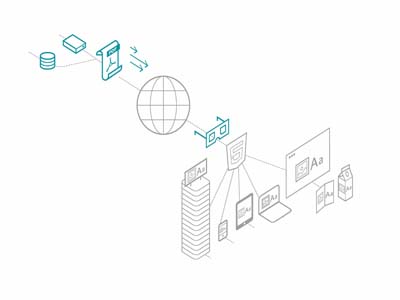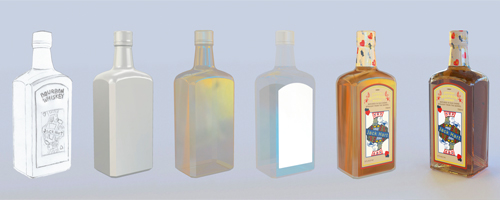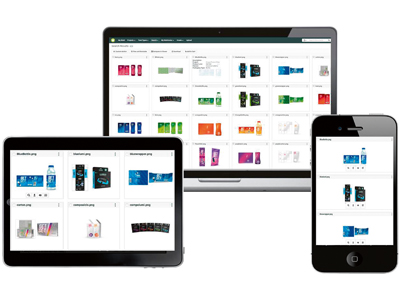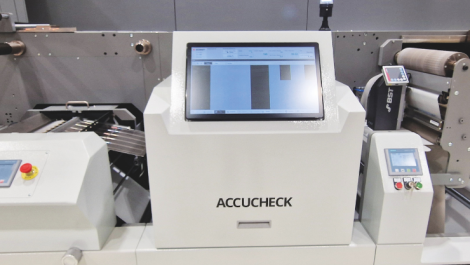Esko WebCenter offers 3D viewing across platforms
A host of upgrades and new products have been announced by software vendors in the lead up to drupa. For the packaging market, there are many improvements promised including better user interfaces, connection to the Cloud and simpler workflows. By Neel Madsen.
A unified workflow linking all areas of production is essential for the label and packaging printer operating in the digital print space. Software development is increasingly taking this need into account by offering closely integrated products that automate the process and cuts out duplication and waste.
Simplification
Esko has overhauled its entire software offering, or suite as it is known, promising a major upgrade throughout and an ‘outstanding user experience’ under the motto ‘Packaging simplified’. During a pre-drupa presentation shared with fellow exhibitors Enfocus and Pantone X-rite, the company unveiled the new name and branding of its software suite, the Esko Software Platform, which it claims is the largest SaaS platform in packaging. (The SaaS, or ‘software as a service’ distribution model sees the vendor or service provider host the applications, licensing them to customers over a network.) The platform has over 30,000 users globally, including 25 global brands, and sees over 500,000 assets uploaded each month. It will be on full commercial release in June.
‘Transforming our software portfolio to an integrated platform is our response to the changing ways customers prefer to buy, use and manage software licences,’ said Bernard Zwaenepoel, Esko senior VP software. He continued, ‘With the SaaS model, Esko hosts and manages the services. Customers can choose the solution they need and run their business without increasing IT overheads and without the potential complexities coming with software upgrades.’
For faster approval cycles, Esko is introducing the Share and Approval Service WebCenter, which allows access to the Cloud directly from Illustrator, ArtiosCAD, Studio, ArtPro+ and Automation Engine. This comes with a new simplified viewer for both approval and search results, which is responsive and mobile friendly across all types of devices. Managing content in WebCenter has also been improved, including the ability to output in Global Standard GS1 format to Adobe Illustrator. There is also improved support for viewing objects in 3D, including transparency and print finishing effects, using a standard web browser on a desktop computer or mobile device.
Studio 16 also has a number of new features, including more scene compositing tools, reasitic floor shadows, high-res pack shots, automation and scripting, Visualizer quality 3D viewers and planogram integration.
Automation Engine 16 has a new Device Manager module that connects its Kongsberg tables and CDIs with the pre-press workflow. It comes with quality control tools from partner Global Vision embedded. Features include a spell checker and automatic checking of barcodes and Braille against an approved profile.
Integrating with AE16 are the editing applications, DeskPack and ArtPro+. The latter is a new 100% PDF native pre-press editor featuring a 64-bit architecture.
User power
Esko subsidiary, Enfocus, launched a new Appstore at the end of February also with the aim of creating a platform to compete on providing services not products. Here users and developers of Enfocus Switch can share their knowledge and work.
Bjorn Willems, director of product management, said, ‘Users of Enfocus Switch now have a valuable resource where they can exchange ideas and technology to improve their businesses – and they have themselves to thank for it. We always knew this was a powerful, connected group of users and the pace of activity at the Enfocus Appstore clearly demonstrates that point. By drupa, it will host close to 50 apps, each providing a solution to a specific business challenge. All of us at Enfocus are excited to be at drupa and to show the industry what can be created by the power of community.’
In addition to these co-created applications, Enfocus is concentrating its efforts on the architecture of the solution, developing features that improve quality and performance while providing greater flexibility. Features under development include an HTML Switch Client that enables users to access Switch from everywhere without the need for locally installed software.
The company is also working on a Cloud-based solution that gives users more flexibility and security. Users can automatically sync Switch assets so that in case of hardware failure, these can be reinstalled on a new server, where the user can log in with their Enfocus ID, and all workflows will be restored.
At drupa, Enfocus will also show a new PDF Review Module, which is the result of an OEM agreement with Chili Publish to integrate its new Chili Rendro technology.
Spicy rendering
Chili Rendro 1.0 is a new way of rendering PDFs via the Cloud that will be shown at drupa. This uses JavaScript SDK to stream actual data not pixels for fast, accurate rendering of PDFs that can then be viewed on any device supporting the HTML5 canvas. It is also available with a 3D module that can show PDF content in actual application scenarios.
CEO Kevin Goeminne explained, ‘Any business that relies on PDFs as part of their operation will tell you that having fast, accurate renderings of PDFs is critical to their success. But until now, these businesses have had to rely on PDFs that don’t accurately represent what the creator intended. Our breakthrough solution solves these challenges by offering the most meticulous rendering, streaming and 3D viewing module of most types of PDF onto any platform that supports the HTML5 canvas.’
Chili Publish now has the fifth version of its Publisher online editing software available. This features a new user experience to cover the wide range of devices used for editing; the software dynamically adapts the workspace to fit the screen size and environment.
The release gives users new effects that can be applied to a frame or text. Users can add an inner shadow to a frame to create an illusion of depth. A glow effect can be added around the text or frame, and a bevel and emboss effect can be used to create an illusion of relief on text or on a frame. Also included are new viewing capabilities for special effects in 3D, such as varnish, gloss and gold simulation.
In colour
PantoneLIVE was first introduced at drupa in 2012 by X-Rite. Described as ‘an end to end solution for the selection, communication, formulation and production of consistent and achievable colours’, it is used by many major brands in order to control colour across products, as complexities in the process create potential for errors.
‘Converters are creating islands of excellence, but there is still variation in colour,’ said Cindy Cooperman, global director of sales, packaging and brand. ‘The reason is that they are pointing to different targets. They are excellent printers in their own space, but for the brand owner, it is a problem.’ She explained that minor errors in the chain can quickly accumulate if there is no communication and this creates variation in the final printed product and serious issues for brands.
The company addresses four core aspects of this issue: colour standards; measurement and calibration; formulation, control and reporting; and professional services. Two new products are now being introduced. One is a private cloud version of PantoneLive and the other a rationalisation service, which will analyse and consolidate a printer’s own colour library to improve color consistency, increase production efficiencies, and avoid duplication.
Colour standards
GMG Color is reorganising its proofing offerings into two lines: GMG ProofMedia Premium and GMG ProofMedia Studio. The Premium line stands for seamless quality and reliable contract proofing, while the Studio range is targeted at creative professionals who need to rapidly produce accurate colours during the design process. As a Fogra development partner, GMG was involved in defining the new Fogra 51/52 characterisation data and its new media portfolio includes proof media with OBAs (optical brightening agents).
The new standards have also been fully integrated to guarantee reliable colours through the GMG OpenColor software. This can calculate profiles that allow for the precise prediction of results, handling the effects of overprinting, changes in substrates, or alterations to the colour sequence. A new feature in OpenColor is the ability to calculate profiles for halftone proofs. To guarantee colour-accurate print output of data calculated in this way, ColorProof is also being updated, promising the reduction of set-up times.
For Adobe Photoshop, the company has developed a new plug-in, a compact tool known as ColorPin, which means users can apply profiles specifically to individual levels or masked areas. In addition, the Pro version also allows users to utilise their own profiles and the colour reduction functionality. There is also a special version for packaging, which adds further features.
GMG will also be offering OpenColor within Hybrid Software’s Packz label and packaging editor. This integration will allow Packz to use the most accurate colour profiles available and use the colour conversion within its PDF editor to ensure accurate transformations. It will make it possible to use any OpenColor proofing profile to create a separation profile directly into the PDF editor, so that only one set of accurate fingerprint characterisation data is required.

Chili Rendro workflow
Real time rendering
Developer of the iC3D packaging design software, Creative Edge Software will introduce version 4 at drupa. iC3D is used for packaging designs in luxury, beverages, food, cosmetics, body and other markets across a range of production methods and applications, including cartons, labels and flexibles for bottles, shrink sleeves/wraps, and POS/POP. The special capabilities of iC3D allow on the fly, real-time, photo realistic generation of 3D digital mock ups on multiple objects, including custom-designed shapes.
Version 4 incorporates a number of new features for unprecedented 3D photorealism developed in response to customer feedback.
‘Our research with key CPG brands, creative agencies, designers and pre-press professionals highlighted difficulties due to the generally fragmented approach to software for packaging ideation, design and production,’ said CEO Nick Gilmore. ‘As well as causing delays and unnecessary cost, it also hampers creativity as a whole, as designers try to second guess possible pitfalls or practical issues before the design goes too far. True photorealism was the missing piece of the puzzle, and for full creative acceptance we needed to nail all aspects of the 3D representation in all environments.’
Five new features have been developed specifically to address this concern. These include Ray Tracing to accurately simulate effects of light on virtual objects for photorealistic, ultra-high resolution, accurate photo studio effects; 3D Model Interiors for realistic liquid filling, at any angle; Light Map Editor to re-create studio lighting, with editable highlights and shadows; Dynamic Backgrounds for real-time merging of 2D photo images with 3D designs; and Perspective Control to match 3D model perspective to 2D photo backgrounds.

From sketch straight through to photorealism with iC3D
Making links
Label Traxx has designed and built its MIS specifically for the label and packaging industry. It will be launching version 8 of its MIS software this spring. The release introduces two new modules, a host of other new features and closer integration with Xeikon presses.
‘In today’s data-driven world, the most successful label companies will have instant access to accurate information in a format that is meaningful – and they may need to share that data with other software systems,’ explained commercial manager Jenny Whittle. ‘The new Label Traxx modules have been developed to address the key demands of our customers and this industry. We are arming our customers to face the challenges of managing a modern business.’
Version 8 features include a new API module enabling the sharing of data with many other systems that support HTTP and SOAP protocols. It can be used to link with CRM systems or shipping manifest and labelling software.
Also new is the Financial Centre module for managing financial accounting within a multi-plant business. As mergers and acquisitions continue to trend in the packaging industry, this new module allows remote locations to send their financial data securely to a central or main location for reporting. New consolidated reporting features allow the viewing of data by location or combined as a single entity.
Finally Label Traxx is introducing new two-way communication with the Xeikon press. Previously the MIS would send job data and artwork files directly to the press. Now, once the job is finished, toner usage is sent back to the system.






